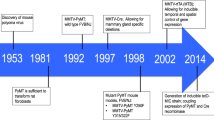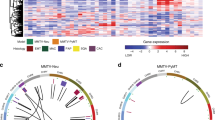Abstract
Understanding the process of carcinogenesis is key to developing therapies which might interrupt or reverse tumor onset and progression. Cell growth and death signals are dependent not only upon molecular mechanisms within a cell but also upon external stimuli such as hormones, cell–cell signaling, and extracellular matrix. Mouse models can be used to dissect these complex processes, to identify key signaling pathways operating at different stages of tumorigenesis, and to test the strength of specific interventions. In the WAP-TAg mouse model, carcinogenesis is initiated by expression of the Simian Virus 40 T antigen (TAg). TAg expression is triggered by hormonal stimulation, either during estrus or pregnancy. Breast adenocarcinomas (ranging from well to poorly differentiated) develop in 100% of the female mice by approximately 8–9 months of age. Three distinct stages of tumorigenesis are easily identified: an initial proliferation, hyperplasia, and adenocarcinoma. The mean time to first palpable tumor in mice which undergo at least one pregnancy is 6 months. The tumorigenic process is marked by a competition between proliferation and apoptosis and is characterized by cellular acquisition of genetic mutations and increased stromal fibrosis. Protein levels of cell cycle control genes cyclin D1, cdk2, and E2F-1 are increased in these adenocarcinomas. c-Fos protein levels are slightly increased in these cancers, while c-Jun levels do not change. Hormonal exposure alters progression. Estrogen plays a role during the early stages of oncogenesis although the growth of the resulting adenocarcinomas is estrogen-independent. Transient hormonal stimulation by glucocorticoids that temporarily increases the rate of cell proliferation results in tetraploidy, premature appearance of irreversible hyperplasia, and early tumor development. Tumor appearance also can be accelerated through over expression of the cell survival protein, Bcl-2. Bcl-2 over expression not only reduces apoptosis during the initial proliferative process but also decreases the total rate of cell proliferation. This block in cell proliferation is lost selectively as the cells transition to adenocarcinoma. The WAP-TAg model can be utilized to investigate how the basic processes of cell proliferation, apoptosis, DNA mutation, and DNA repair are modified by external and internal signals during mammary oncogenesis.
This is a preview of subscription content, access via your institution
Access options
Subscribe to this journal
Receive 50 print issues and online access
$259.00 per year
only $5.18 per issue
Buy this article
- Purchase on Springer Link
- Instant access to full article PDF
Prices may be subject to local taxes which are calculated during checkout









Similar content being viewed by others
Abbreviations
- WAP:
-
whey acidic protein
- TAg:
-
Simian virus 40 large T antigen
- WAP-TAg:
-
a transgenic mouse model of breast cancer progression in which TAg expression is targeted to mammary epithelial cells using the WAP promoter
- pRb:
-
Retinoblastoma protein
- H&E:
-
hematoxylin and eosin
- PCNA:
-
proliferating cell nuclear antigen
- PBS:
-
phosphate buffered saline
- DAB:
-
diaminobenzidine
- WT:
-
wild-type nontransgenic control mice
- ovx:
-
ovariectomy
- wk:
-
weeks
- PCR:
-
polymerase chain reaction
- DMBA:
-
dimethylbenz(a)anthracene
- TGF-β:
-
transforming growth factor-β
References
Demeril D, Laucirica R, Fishman A, Owens RG, Grey MM, Kaplan AL and Ramzy I. . 1996 Cancer 77: 1494–1500.
Dyson N, Buchkovich K, Whyte P and Harlow E. . 1989 Cell 58: 249–255.
Ewald D, Li M, Efrat S, Auer G, Wall RJ, Furth PA and Hennighausen L. . 1996 Science 273: 1384–1386.
Feng Z, Marti A, Jehn B, Altermatt HJ, Chicaiza G and Jaggi R. . 1995 J. Cell Biol. 131: 1095–1103.
Furth PA, Bar-Peled U, Li M, Lewis A, Laucirica R, Jager R, Weiher H and Russell RG. . 1999 Oncogene 18: 6589–6596.
Hahn WC, Counter CM, Lundberg AS, Beijersbergen RL, Brooks MW and Weinberg RA. . 1999 Nature 400: 464–468.
Hedley DW, Friedlander ML, Taylor IW, Rugg CA and Musgrove EA. . 1983 J. Histochem. Cytochem. 31: 1333–1335.
Hennighausen L, Robinson GW, Wagner KU and Liu W. . 1997 J. Biol. Chem. 272: 7567–7569.
Horak E, Smith K, Bromley L, LeJeune S, Greenall M, Lane D and Harris AL. . 1991 Oncogene 6: 2277–2284.
Lee EYH, To H, Shew JY, Bookstein R, Scully P and Lee WH. . 1988 Science 241: 218–221.
Li M, Hu J, Heermeier K, Hennighausen L and Furth PA. . 1996a Cell Growth Differ. 7: 3–11.
Li M, Hu J, Heermeier K, Hennighausen L and Furth PA. . 1996b Cell Growth Differ. 7: 13–20.
Li M, Liu X, Robinson G, Bar-Peled U, Wagner KU, Young WS, Hennighausen L and Furth PA. . 1997 Proc. Natl. Acad. Sci. USA 94: 3425–3430.
Lund R, Romer J, Thomasset N, Solberg H, Pyke C, Bissell MJ, Dano K and Werb Z. . 1996 Development 122: 181–193.
Meitz JA, Unger T, Huibregtse JM and Howley PM. . 1992 EMBO J. 11: 5013–5020.
Murphy KL, Kittrell FS, Gay JP, Jäger R, Medina D and Rosen JM. . 1999 Oncogene 18: 6597–6604.
Newcomb PA. . 1997 J. Mammary Gland Biol. Neoplasia 2: 311–318.
Santarelli R, Tzeng YJ, Zimmermann C, Guhl E and Graessmann A. . 1996 Oncogene 12: 495–505.
Schorr K, Li M, Bar-Peled U, Lewis A, Heredia A, Lewis B, Knudson CM, Korsmeyer S, Jager R, Weiher H and Furth PA. . 1999a Cancer Res. 59: 2541–2545.
Schorr K, Li M, Krajewski S, Reed JC and Furth PA. . 1996b J. Mammary Gland Biol. Neoplasia 4: 153–164.
Shibata M-A, Liu M-L, Knudson CM, Shibata E, Yoshidomo K, Bandey T, Korsmeyer SJ and Green JE. . 1999 EMBO J. 18: 2692–2701.
Topper YJ and Freeman CS. . 1980 Physiol. Rev. 60: 1049–1060.
Tzeng Y-J, Guhl E, Graessmann M and Graessmann A. . 1993 Oncogene 8: 1965–1971.
Tzeng YJ, Gottlob K, Santarelli R and Graessmann A. . 1996 FEBS Lett. 380: 215–218.
Vindelov LL, Christensen IJ and Nissen NI. . 1983 Cytometry 3: 323–327.
Acknowledgements
The technical assistance of Shawnté Hudgins, Albert Lewis, and Shuxun Ren for care of the mice and Ud Bar-Peled for preparation of the Western blot in Figure 4e is gratefully acknowledged. This work was supported in part by NIH grant CA70545 (to PA Furth), Department of Defense Grant DAMD17-98-1-8204 (to PA Furth), and the Veterans Administration Research Service (to PA Furth).
Author information
Authors and Affiliations
Rights and permissions
About this article
Cite this article
Li, M., Lewis, B., Capuco, A. et al. WAP-TAg transgenic mice and the study of dysregulated cell survival, proliferation, and mutation during breast carcinogenesis. Oncogene 19, 1010–1019 (2000). https://doi.org/10.1038/sj.onc.1203271
Published:
Issue Date:
DOI: https://doi.org/10.1038/sj.onc.1203271



